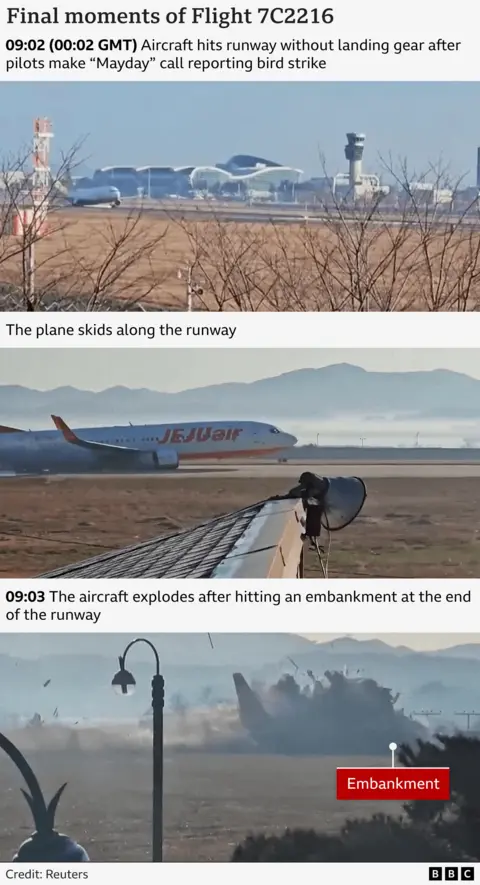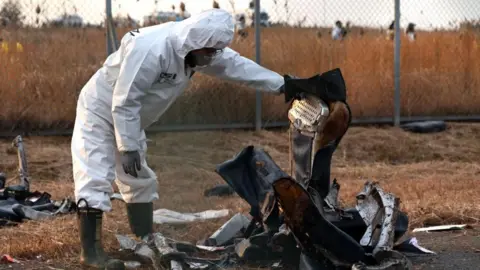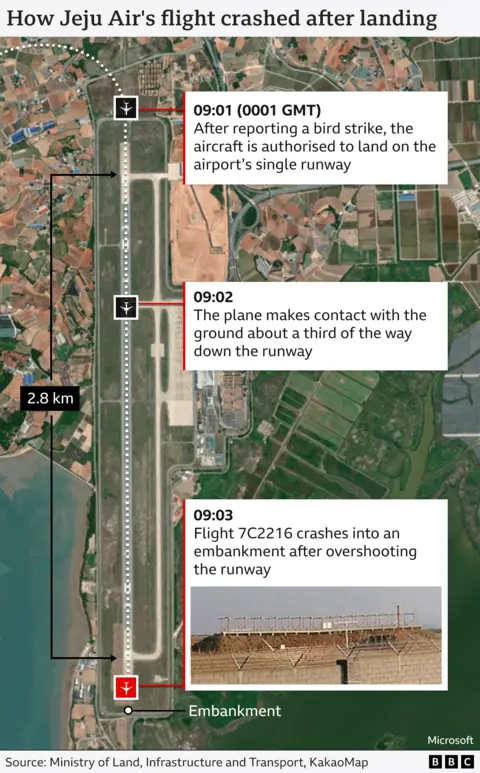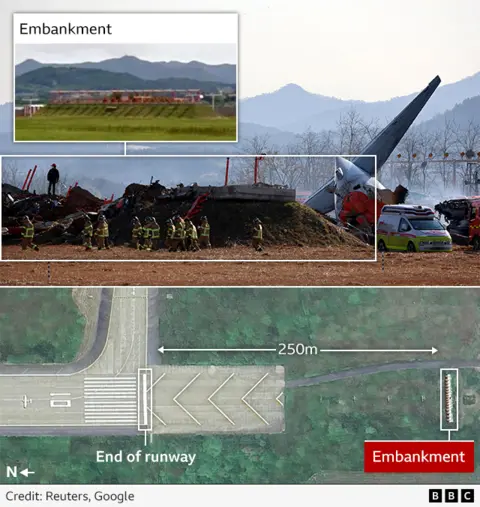Practically 180 folks died after a airplane crashed because it was touchdown in South Korea on the morning of Sunday 29 December.
Harrowing video footage exhibits the Jeju Air airplane coming off the runway earlier than colliding with a barrier and bursting into flames at Muan Worldwide Airport.
The airplane, which was getting back from Bangkok, Thailand, was carrying 181 folks – 179 of whom had been killed. Two crew members had been rescued from the wreckage.
Authorities are investigating the reason for the crash, with hearth officers indicating a fowl strike and unhealthy climate. Nevertheless specialists have warned the crash might have been brought on by quite a few elements.
What occurred?
Flight 7C2216 was a Boeing 737-800 operated by Jeju Air, Korea’s hottest funds airline.
Air visitors management authorised the airplane to land at Muan Worldwide Airport at about 08:54 (23:54 GMT) – simply three minutes earlier than issuing a warning about fowl exercise within the space.
At 08:59, the pilot reported that the airplane had struck a fowl, declaring “mayday mayday mayday” and “fowl strike, fowl strike, go-around”. The pilot then aborted the unique touchdown and requested permission to land from the wrong way.
Air visitors management authorised the choice touchdown at 09:01 – and at 09:02 the airplane made contact with the bottom, coming down at roughly the midway level of the two,800m runway.
One video seems to point out the airplane touching down with out utilizing its wheels or another touchdown gear. It skidded down the runway, overshot it and crashed right into a concrete wall, earlier than erupting into flames.
A witness informed the South Korean information company Yonhap that they had heard a “loud bang” adopted by a “sequence of explosions”.
Movies from the scene present the airplane ablaze with smoke billowing into the sky. The primary of two survivors was rescued from the crash at about 09:23, with the second being rescued from contained in the tail part of the airplane at about 09:50.

May a fowl strike have contributed to the crash?
Lee Jeong-hyun, chief of the Muan hearth division, informed a televised briefing {that a} fowl strike and unhealthy climate might need precipitated the crash – however that the precise trigger was nonetheless being investigated.
The flight and voice recorders from the airplane had been recovered, although experiences say that the previous was broken and that information from the units might take as much as a month to decode.
One passenger on the flight messaged a relative, saying {that a} fowl had been “caught within the wing” and that the airplane couldn’t land, native media reported.
Officers, nevertheless, haven’t confirmed whether or not the airplane did truly collide with any birds.
The top of Jeju Air’s administration stated that the crash was not as a consequence of “any upkeep points”.
The South Korean transport division stated that the pinnacle pilot on the flight had held the function since 2019 and had greater than 6,800 hours of flight expertise.
Geoffrey Thomas, an aviation professional and editor of Airline Information, informed the BBC that South Korea and its airways had been thought-about “trade finest observe” and that each the plane and the airline had an “glorious security file”.
Mr Thomas individually informed Reuters information company that he was sceptical {that a} fowl strike alone might have precipitated the crash.
“A fowl strike shouldn’t be uncommon. Issues with an undercarriage will not be uncommon. Chook strikes occur way more typically, however sometimes they do not trigger the lack of an airplane by themselves,” he stated.
Who’re the airplane crash victims and survivors?
The airplane was carrying 175 passengers and 6 crew. Two of the passengers had been Thai and the remainder are believed to have been South Korean, authorities have stated. Many are thought to have been getting back from a Christmas vacation in Thailand.
The official loss of life toll stands at 179 – making it the deadliest airplane crash on South Korean soil.
All of the passengers and 4 members of crew died.
Authorities have to this point recognized 174 our bodies and are nonetheless checking the remaining 5 “as a consequence of DNA inconsistencies”, in line with Yonhap.
Officers have been amassing saliva samples from relations gathered at Muan Airport to assist determine our bodies of victims. Different victims have been recognized by their fingerprints.
5 of the individuals who died had been youngsters beneath the age of 10. The youngest passenger was a three-year-old boy and the oldest was 78, authorities stated, citing the passenger manifest.
“I am unable to consider your complete household has simply disappeared,” Maeng Gi-Su, 78, whose nephew and grand-nephews had been on the flight, informed the BBC. “My coronary heart aches a lot.”
South Korea’s Nationwide Fireplace Company stated two members of the flight crew – a person and a girl – had survived the crash.
The person has woken up and is “totally in a position to talk”, in line with Yonhap, which cites the director of the Seoul hospital the place he’s being handled.
Greater than 1,500 emergency personnel have been deployed as a part of restoration efforts, together with 490 hearth workers and 455 law enforcement officials. They’ve been looking out the realm across the runway for components of the airplane and people who had been onboard.
 EPA
EPAWhy was there a concrete wall on the finish of the runway?
Aviation specialists have raised questions on an “uncommon” concrete wall close to the runway and its function within the crash.
Footage exhibits the airplane coming off the runway earlier than colliding with the wall and bursting into flames.
Air security professional David Learmount stated that, had the “obstruction” not been there, the airplane “would have come to relaxation with most – presumably all – these on board nonetheless alive”.
“Sadly, that factor was the explanation that everyone obtained killed, as a result of they actually hit a concrete construction,” Captain Ross Aimer, the chief govt of Aero Consulting Specialists, informed Reuters information company. “It should not have been there.”
Aviation analyst Sally Gethin questioned whether or not the pilot knew the barrier was there, notably given the airplane was approaching from the wrong way from the standard touchdown method.
The concrete construction holds a navigation system that assists plane landings – generally known as a localiser – in line with Yonhap.
At 4m excessive, it’s lined with dust and was raised to maintain the localiser stage with the runway to make sure it capabilities correctly, Yonhap reported.
South Korea’s transport ministry has stated that different airports within the nation and a few abroad have the gear put in with concrete buildings. Nevertheless officers will look at whether or not it ought to have been made with lighter supplies that may break extra simply upon influence.

South Korean officers have stated the construction was about 250m (820ft) from the tip of the runway and most airports within the nation comply with worldwide guidelines recommending a security space of 240m (787ft).
Nevertheless, remarks within the airport’s working handbook, uploaded early in 2024, stated the embankment was too near the tip of the runway and advisable that the placement of the gear be reviewed throughout a deliberate growth.
Former pilot John Cox, chief govt of Security Working Techniques, informed Reuters the runway design “completely (did) not” meet trade finest practices, which preclude any arduous construction inside at the least 300m (984ft) of the tip of the runway.
South Korea’s director-general for airport coverage, Kim Hong-rak, stated the federal government would “overview the related rules and their software”.
At a information convention on Tuesday, Jeju Air’s chief govt Kim Yi-bae appeared to sidestep a query concerning the wall.
Requested by a reporter if he thought the wall was an element within the catastrophe, he didn’t give a direct reply and as an alternative stated it was proper to name the airplane crash the Jeju Air catastrophe, fairly than the Muan Air catastrophe.

What has the airline stated?
Talking on Tuesday, Jeju Air’s chief govt stated the airline would scale back its air visitors this winter by 10-15% to hold out extra upkeep work.
However Kim Yi-bae stated this was not an admission that the corporate was working too many planes.
No points had been delivered to mild when the airplane was inspected on the day of the crash – and the airline was monitoring the climate each earlier than and after the flight, he added.
Mr Kim stated a distinct Jeju flight confronted points with its touchdown gear on Monday and was compelled to return to Seoul’s worldwide airport however it has been declared secure.
He stated the pilot had noticed that casing to entry the touchdown gear was barely open and reported this, with the airplane returning to the airport for upkeep.
The airplane had additionally been a Boeing 737-800, the identical mannequin because the plane that crashed on Sunday.
In his information convention, Mr Kim stated Jeju Air had paid essentially the most fines and confronted essentially the most administrative motion of any Korean airline over the past 5 years. However he insisted the airline has persistently improved its security file.
He stated the corporate had a strict upkeep guidelines, including: “If one thing was missed it could be a grave downside.”
Jeju Air has apologised to the victims’ households and vowed to offer emergency compensation and canopy funeral prices.
The corporate’s chief govt stated the airline had no historical past of accidents and it’s believed Sunday’s crash has been its solely deadly accident because it was launched in 2005.
What are officers doing now?
South Korea’s Appearing President Choi Sang-mok has ordered an emergency security inspection of the nation’s complete airline operations, which is about to be accomplished by 3 January.
Muan has additionally been declared a particular catastrophe zone, which makes central authorities funding obtainable to the native authorities and victims.
All flights to and from Muan Worldwide Airport have been cancelled, with the airport staying closed till 7 January.
A “black field” flight information recorder recovered from the crash website was lacking a key connector and authorities had been reviewing find out how to extract its information. Nevertheless retrieval of knowledge from the cockpit voice recorder has begun, South Korea’s transport ministry stated.
A nationwide seven-day interval of mourning has been declared, and New 12 months’s Day celebrations within the nation are prone to be cancelled or scaled down.
Plane maker Boeing has stated it’s in contact with Jeju Air and stands “able to help them”.

What’s a fowl strike?
A fowl strike is a collision between a airplane in flight and a fowl. They’re quite common – within the UK, there have been greater than 1,400 fowl strikes reported in 2022, solely about 100 of which affected the airplane, in line with information from the Civil Aviation Authority.
The most effective recognized fowl strike occurred in 2009, when an Airbus airplane made an emergency touchdown on New York’s Hudson River after colliding with a flock of geese. All 155 passengers and crew survived.
Professor Doug Drury, who teaches aviation at CQUniversity Australia, wrote in an article for The Dialog this summer time that Boeing planes – like Airbus and Embraer – had turbofan engines, which could possibly be severely broken in a fowl strike.
He stated that pilots had been skilled to be particularly vigilant in the course of the early morning or at sundown, when birds had been most energetic.
However some aviation specialists are sceptical about whether or not a fowl strike might have precipitated the crash at Muan Airport.
“Sometimes they [bird strikes] do not trigger the lack of an airplane by themselves,” Mr Thomas informed Reuters.
Australian airline security professional Geoffrey Dell additionally informed the information company: “I’ve by no means seen a fowl strike stop the touchdown gear from being prolonged.”




